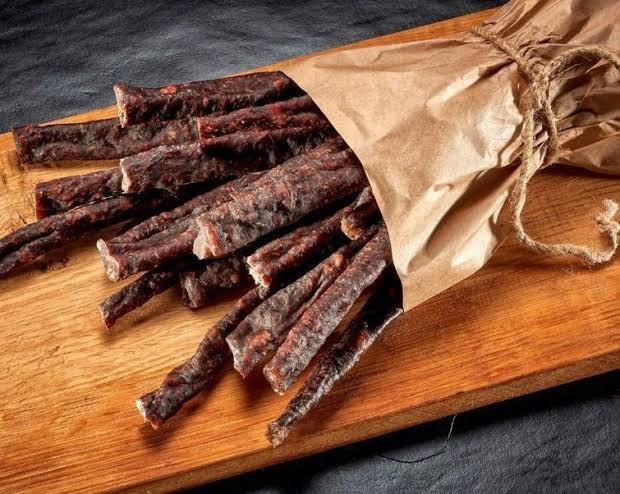Africa and indeed the African Diaspora is the home of very delicious, classic and even spiritual meals. At ILoveAfrica, we love to share very exotic meal recipes from all over the continent; and today, in the spirit of celebrating Namibia’s 32nd independence anniversary which was only a few days ago (March 21); we have Biltong, a tasty beef jerky.

Biltong was originally created by Dutch pioneers in Southern Africa; “Voortrekkers”, who needed reliable food sources on their long treks across the African continent. The method and spice mix hasn’t changed much in hundreds of years; but a few variations have appeared recently, like ‘piri piri’ biltong and the use of additional ingredients like worcestershire sauce and dried chillies.
Ingredients for Biltong
Meat
- 2000 g Beef—silverside or toprump
Curing spice mix
- 5 tbsp Brown (malt) or cider vinegar
- 2.5 tbsp Coarse salt (2% of the meat weight)
- 2 tsp Ground black pepper
- 2 tbsp Coriander seed
- 1.5 tbsp Brown sugar
Instructions
-
Toast the coriander seeds in a dry pan, then grind down in a pestle and mortar or spice grinder. It should be mostly powder, with a few pieces of seed shells left in.
-
Using a sharp knife, following the grain of the meat, cut into 1 inch (2.5cm) thick lengths and place in a non-metallic container.
-
Combine all the spices and sprinkle into the meat. Sprinkle the vinegar on and rub everything in thoroughly whilst turning the meat with your hands.
-
Cover the container and let your biltong cure for 24 hours in the fridge, turning and rubbing through the meat occasionally.
-
Remove the meat from the container and pat dry with kitchen towels, taking care not to remove too much of the spice.
-
Add a hook to the thickest end of each length. Plastic-covered paper clips make for a cheap solution. Hang in your biltong box, or in a well aired, ventilated space with a fan blowing gently to increase air flow. Do not point a fan directly at the meat (to avoid case hardening). Make sure none of the pieces are touching. Place some newspaper below the meat to catch any liquid.
-
Drying times will vary with humidity, airflow and temperature. Test the readiness of your biltong every couple of days by squeezing the sides together with clean fingers. If you feel any give in the meat, it’s still ‘wet’ inside.
-
Once ready, cut into thin slices with a sharp knife and enjoy some of the best meat you’ll ever eat.

Notes on the recipe
If you are using venison or game, or cheaper cuts of beef, add 2 tsp of bicarbonate of soda to tenderise the meat.
If you don’t have any coarse salt and need to substitute with table salt, double-check that it’s not iodised salt – iodine leaves a bitter taste in the mouth.
